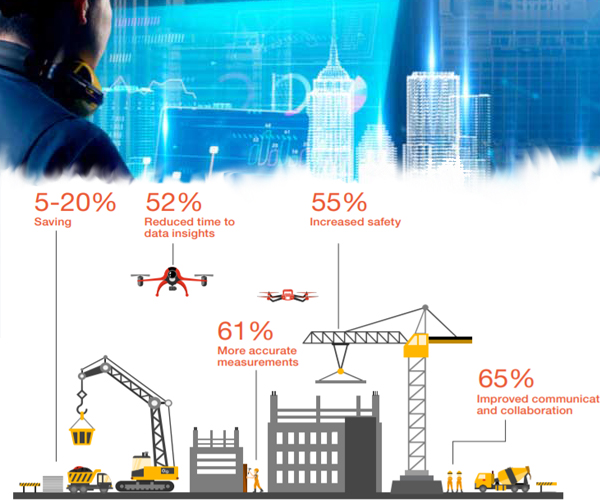Drones in Construction and Infrastructure
Drones have become an essential tool in the construction industry, with their use rapidly increasing and becoming the most widely used emerging technology. The advantages of utilizing drones in construction are numerous and have greatly improved efficiency, accuracy, and safety on job sites.
One of the key benefits of using drones is their ability to conduct site surveys at a much faster rate with greater precision compared to traditional ground crews. Furthermore, aerial imaging through drones is a significantly more cost-effective option. With high-resolution cameras and data collection capabilities, drones can generate interactive 3D or topographical maps and models, as well as accurately measure volume.
In addition to surveying capabilities, drones offer the unique advantage of inspecting hard-to-reach areas such as bridges or tall buildings in a safe manner. This eliminates potential risks for workers and enables thorough monitoring of progress on a job site.
The impact of drones in construction and infrastructure has revolutionized the entire project life cycle. They facilitate regular tracking of construction progress, streamline communication and decision-making processes, create detailed maps and 3D models, and ensure worker safety by keeping them out of hazardous areas.
It is clear that drones play a crucial role in modern construction practices. Their application not only improves efficiency but also enhances overall project management. As we continue to advance technologically, it will be exciting to see how drones further transform the way we approach construction and infrastructure projects.
- Initial Site Assessment and Measurement
Utilizing drone surveying technology results in highly accurate terrain data and precise mapping of the area. Drones have the capability to thoroughly and precisely survey the entire terrain, eliminating any obstacles in their path.
It should be noted that drones do not replace traditional mapping methods or manual processes, but rather enhance the efficiency and accuracy of this crucial step.
- Workflow Monitoring
Monitoring different stages of a project from beginning to end is an integral part of daily work for civil construction professionals such as engineers, architects, and technicians. The more detailed information obtained at each stage, the better equipped these professionals are to identify issues and propose solutions.
However, one drawback of using these drones is their difficulty in handling as any slight imbalance can result in collision with objects in their surroundings.
3.Hybrid Fixed-Wing
There are also hybrid models available that combine features from both fixed-wing and multi-rotor drones. These hybrids possess the endurance and efficiency of fixed-wing drones while still being able to vertically take off and land like multi-rotor ones. However, due to its advanced capabilities, this VTOL drone model comes at a higher cost and requires additional training for proper operation.
Challenges Arising from the Use of Drones in Construction and Infrastructure
The using of Drones in the construction industry is increasing day by day due to their efficiency and effectiveness. It faces Different type of Challenges and able to solve all these. We are here to discuss some of the main challenges faced when using drones in construction.
Weather Dependence
One significant challenge with drones is their reliance on favourable weather conditions. Due to their lightweight and compact design, they can easily be affected by windy conditions, causing them to deviate from their intended flight path or resulting in unreliable data or imagery collection. While there are advanced drones available that can withstand gusts of wind, this remains a limitation for many models.
Uncertainty in Legislation
The laws surrounding drone use are constantly evolving, leading to uncertainty for those looking to incorporate them into construction projects. This often results in delays as individuals struggle to obtain necessary permits and comply with changing regulations. This is especially prevalent in large urban areas where strict regulations may apply.
User Privacy and Security Concerns
Drones are using and widespread for its privacy and security concern. It can capture high-quality images and videos from above. There is potential for sensitive information to be collected without adequate knowledge. It would be a security risk factor if they fall into the wrong hands.
Legal Issues and Unfair Use
Misuse or unsafe operation of drones can lead to legal issues for both individuals and companies involved in construction projects. There have been cases where unauthorized drone flights have caused accidents or disruptions at job sites, resulting in legal action being taken against the drone operators.
Drones are susceptible to attacks from wild animals and their presence can disrupt natural wildlife behavior. When operating in areas with a significant amount of wildlife, drones may encounter collisions with animals or obstacles such as trees. Particularly large birds of prey, like hawks, have been known to attack or even capture drones that enter their territory.
Furthermore, the effective use of drones in construction relies heavily on the pilot’s knowledge and proficiency in handling the device. As mentioned earlier, inexperienced pilots pose a significant risk for causing drone accidents. Therefore, it is recommended that construction workers receive thorough training or utilize the services of experienced third-party drone operators to ensure accurate and high-quality data collection and analysis.
Moreover, like most devices connected to the internet, drones are vulnerable to hacking attempts. Security experts have identified ways for hackers to access private information or cause damage to commercial drones by targeting their central control systems from distances up to one mile away. This highlights the importance of implementing robust security measures when utilizing drones for any purpose.



